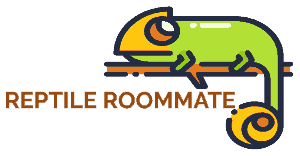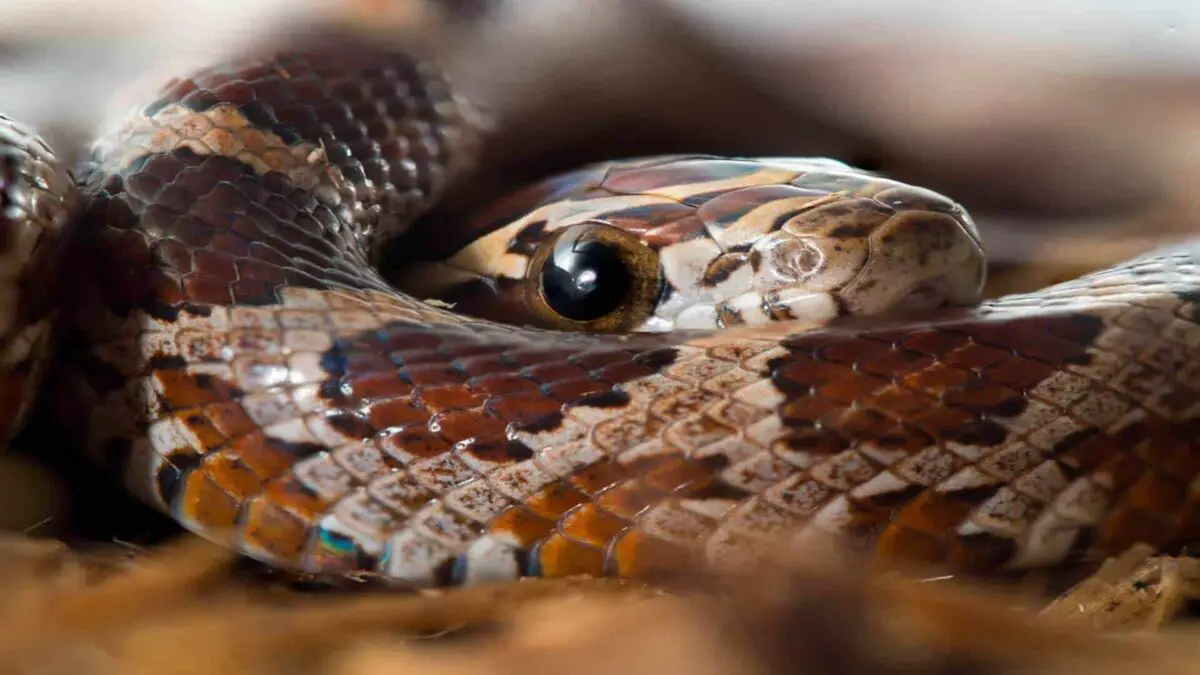Comprehensive Corn Snake Care Guide
Corn snakes make excellent pets and they are one of the most popular reptiles kept by hobbyists. In this care guide you’ll learn everything needed to set up, maintain, and care for your very own corn snake!
Reptile Roommate is a participant in the Amazon Services LLC Associates Program. As an Amazon Associate I earn from qualifying purchases.
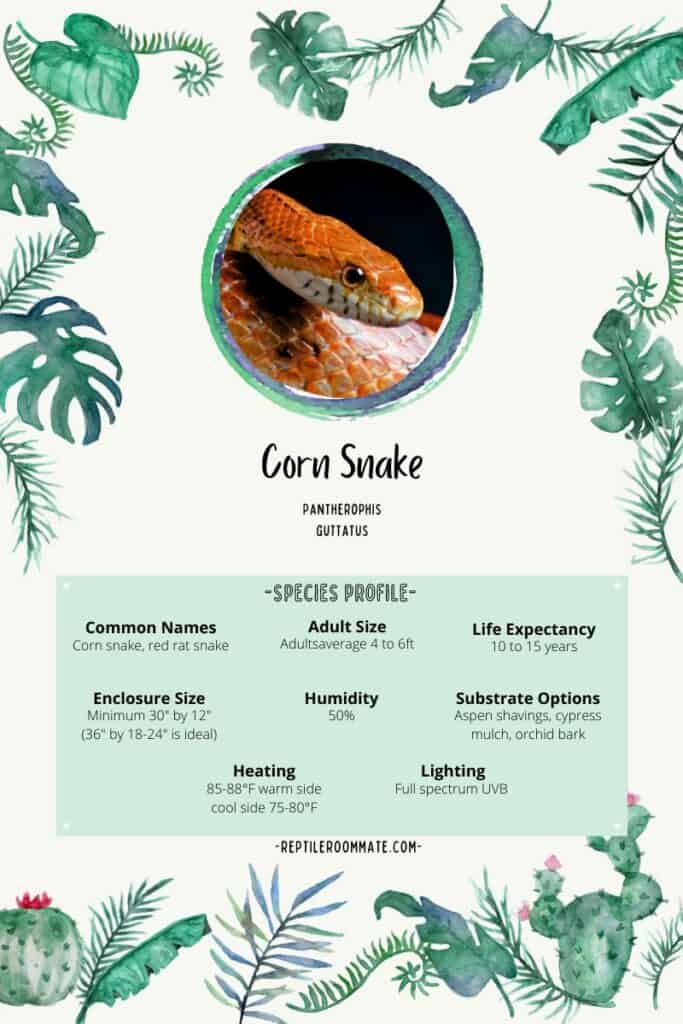
Corn Snakes make great pets but if you’d like another option, you can’t go wrong with a ball python! Check out our guide here…
Corn Snake Natural Habitat
Corns are a North American species of snake found throughout the southeastern and central U.S.
Corn snakes get their name because of the species presence around and near stores of grain, where they prey on mice and rats that feed on corn.
A case can also be made that the name “corn snake” comes from their unique checker-like belly pattern which resembles the colors and pattern of variegated corn.
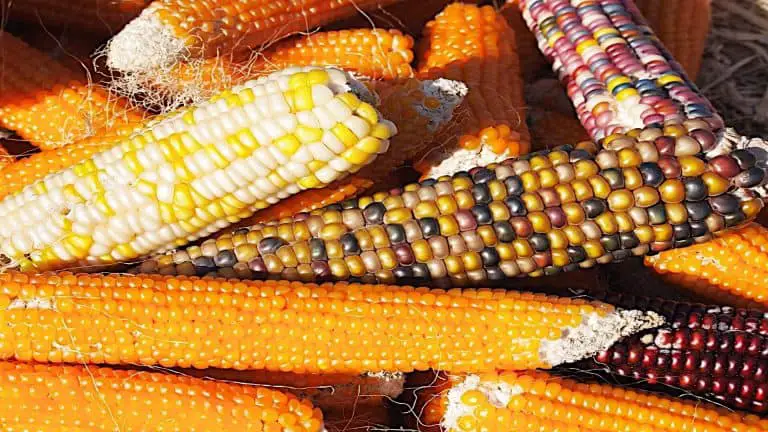
“PA120838 Ardenwood 20131012” by Pussreboots is licensed under CC BY- 2.0
Corn Snake Size
Corn snakes average 4-6 ft in length. Females are usually 1-1.5 ft longer than the shorter males.
Corns are relatively slender, averaging around 700 grams (1-2 lbs) or so; certainly nothing like the thicker and more muscular ball python.
Lifespan
Corn snakes can live on average, for approximately 10-15 years, although some individuals have lived well into their 20s or even 30s!
Be aware that a corn snake is a commitment of a decade or more!
Colors and Morphs
In the wild corn snakes are orange with black lines surrounding red saddle markings and with black and white checkered bellies.
There are also natural occurring variations like the Miami phase (contrasting light silver/grey along with orange saddles) and the Okeetee phase (deep red saddle marks with very dark black borders)
Generation after generation of selective breeding has led corn snakes to be found in almost endless color and pattern combinations!
Color morphs like:
Candy Cane, Reverse Okeetee, Fluorescent orange, Sunglow, Blood red, Caramel, etc, etc…
Pattern morphs like:
Motley, Striped, Aztec, Banded, etc, etc
Even compound morphs (color and pattern mutations) and now scaleless corns!!
…and the list goes on and on….
You’ll have no difficulty finding the “perfect” corn snake for you!
Are Corn Snakes Difficult to Keep?
Corn snakes are probably the BEST pet snake for beginners! (but they’re not just for beginners!)
Corns are easy to care for snakes, that are of a good size without being too large (and intimidating) or too small and fragile for young hands or beginner mistakes.
Their docile nature and low key attitude make them unlikely to bite or be aggressive.
Handling
Corn snakes are a joy to handle.
Corns are quicker and a bit more challenging to handle than say a ball python, but that is only because of their comparatively smaller size and faster movements.
Juvenile corns are understandably cautious and much more nervous because of their vulnerability and inability to defend themselves.
However, with frequent handling and exposure to you, they will tame very easily and begin to trust you quickly.
Like with any animal, initial contact should be slow and steady with trust being developed over a period of time; gentle handling of the snake for a few minutes every day or so for a week to a couple of weeks is perfect.
Once your corn snake realizes that you pose no threat, they can be handled with ease and are a pleasure to hold. That said, there are occasions when it’s best to not handle your corn snake.
You should avoid handling your corn when it is in shed because the snake’s reduced vision and vulnerability can cause great stress and even an attempted bite.
You also shouldn’t handle your snake after it has consumed a meal.
Waiting a few days after you corn snake has eaten will help to ensure that it doesn’t stress it out and lead to it regurgitating its meal.
Corn Snake Enclosures
Corn snakes not only like to burrow and bury themselves but they are also excellent climbers, not to mention, escape artists!
A tight fitting lid is an absolute requirement!
Also, be sure to check your enclosure for small gaps or spaces like in some popular open-front terrariums. Too big of a gap and your slippery friend might just slip away!
Single corn snakes (ALL corn snakes should be housed alone) can be housed in a 20 gallon long aquarium – 30” x 12” – up to a 40 gallon breeder aquarium for the largest of corn snakes. – 36” x 18” –
Some snake keepers, and especially breeders keep their corns in a rack system. Most corn snake rack systems use tubs of @ 30”+ x 12”.
A couple of advantages to rack systems are that it allows breeders to house large numbers of snakes and it affords easy cleaning and maintenance of the enclosure.
Larger enclosures are very nice both for you and your corn snake.
Just remember that larger enclosures (and the numerous hides and decorations that you put inside them) need to be kept clean resulting in more maintenance.
So, while some may frown on snakes being kept in a rack system, cleanliness and the snakes welfare ALWAYS need to come first.
If having a rack system means that you’ll be able to provide a cleaner, healthier, and more stable environment then they are a great way to house your snake.
You will need to spot clean the enclosure as needed and do a full tear down of the tank/habitat monthly to clean and disinfect it. Cleanliness = a happy keeper and an even happier snake!
Corn snakes should always be housed individually and not in pairs or groups. Corns snakes can and will consume other cage mates given the opportunity!
Humidity
Your corn snake enclosure should have an average of around 50% humidity.
Using a hydrometer, a device for measuring humidity, makes easy work of maintaining proper humidity levels. Fortunately they are inexpensive and readily available.
Some good ways to increase humidity in your corn’s enclosure would be to add a moist hide or place its water bowl over the under-tank heating element.
Substrate
Corn snake’s love to hide and burrow into their substrate.
Substrates such as aspen shavings, cypress mulch and orchid bark help maintain humidity and provide a medium that allows that burrowing behavior.
No matter what substrate you choose, remember that it will need to be efficiently and effectively cleaned on a regular basis.
Never use substrates containing cedar as it is deadly to reptiles.
Hides
A necessity for any corn snake enclosure is two or more hides or shelters. Most snakes prefer a dark secure place to spend much of their time.
The hides you provide give your corn a secure place to feel safe. It is preferable to have at least one hide in both the warm and cool sides of the enclosure.
The more hides and safe places you can provide your snake the less stress it will have and the more comfortable it will be.
Heating
Corn snakes need temperature gradients (zones). Their enclosure should have a “warm side” and a “cool side.”
The warm side should range in temperature from 85-88°F and the cool side from 75-80°F.
You can heat your corn snake’s enclosure by using an under-tank heating pad or mat.
You can also heat the enclosure with a heating lamp or ceramic heat emitter directed from the outside of the enclosure. (set on top of the screen lid)
NEVER use heating rocks or stones that go inside of the habitat. These can cause severe burns and even death!
An accurate thermometer is a must for any reptile enclosure.
Lighting
Corn snakes are mostly nocturnal and have no need for special UVB or supplemental lighting.
However, a photoperiod of 10-12 hrs a day by using a simple fluorescent light (on a timer or turned on/off manually) is standard practice.
Food and Water
Clean, fresh water should be available at all times
A large, stable water dish should be provided. The water dish should be large enough that your corn snake can soak in it. Soaking can be very important during shedding.
The water dish should be cleaned and disinfected weekly and as needed.
Corn Snake Feeding Chart
This “guide” is generic and ONLY a guide. Common sense, personal knowledge, and experience with YOUR snake should help you make informed feeding decisions.
There are and always will be exceptions to every rule and recommendation.
This guide is meant to be a starting point in your research and in your individual experience.
| Snake Weight | Mouse Size | Qty | Frequency |
|---|---|---|---|
| 4-15 g | Pinkie | 1 | 4-5 days |
| 16-23 g | Pinkie | 2 | 5-6 days |
| 24-30 g | sm Fuzzy | 1 | 6-7 days |
| 30-50 g | Fuzzy | 1 | 6-7 days |
| 51-90 g | Hopper | 1 | 6-7 days |
| 91-170 g | md adult | 1 | 7 days |
| 170+ g | lg Mouse | 1 | 7-10 days |
| 400+ g | xl Mouse | 1 | 10+ days |
Feeder rodents
Should you feed live rodents or feed previously killed frozen (and then thawed) rodents?
The best option, for both you and your corn snake, is to purchase frozen rodents that you can thaw and feed to your snake.
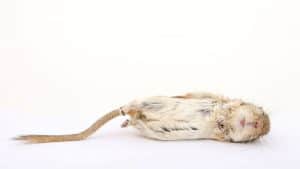
Benefits of feeding frozen/thawed:
- It is convenient
- It’s parasite free
- Rodents cannot harm or cause injury
- More economical because you can buy in bulk
- Frozen rodents are easier to store than live rodents
In a captive environment feeding live animal prey is not ideal for a number of reasons.
3 reasons not to feed live rodents
- If left unattended a live rodent can harm, injure or (yes) even kill your snake
- There is the possibility of introducing disease or pests to your snake/enclosure
- Live rodents can be difficult/time consuming/messy/smelly to house
Rodent bites can do great harm to your snake. IF you do feed live rodents make sure not to leave your snake (and the rodent) unattended until the snake has captured and constricted its prey.
Shedding
Corn snakes continue to grow throughout their lives and as their body increases in size they need to shed their skin to accommodate for this growth.
Shedding can also be beneficial because it may help remove parasites like mites or ticks.
Snakes go through a shedding cycle which can last between 1 and 2 weeks.
The Pre-shed
During this pre-shedding phase you’ll notice that your corn’s colors appear dull and a bit darker than usual. You may also notice your snake’s eyes becoming darker as well or appearing faded.
Your snake may begin to refuse to eat at this point which is completely normal.
(once they do refuse food, it’s probably best to stop offering it until they have completed their shed)
Blue
The second part of the pre-shed is what’s known as “being in blue” or the “blue phase.”
Being in blue means that your corn snake’s eyes will get cloudy, and appear to be a milky-blue color. Your snake’s skin will also appear to be a lot less colorful and much duller than it usually does.
Your corn is easily stressed during this stage. Cloudy eyes make it hard to see and the impending shed can make your corn snake particularly uneasy.
Your snake will spend much of its time hiding and become defensive if you attempt to handle it or are active in its enclosure. It’s best to just give your snake the space it needs.
It can be a good idea to keep a diligent eye on the enclosure’s humidity levels; even increasing them a bit up to 60% or so.
You can introduce a “humidity box,” or hide filled with slightly damp sphagnum moss to assist your snake in the shedding process.
Approximately 3-5 days later your corn snake may begin to look “normal” again. Many new snake keepers wonder, “What happened? Is my corn not going to shed now?”
Clearing
This “clearing stage” is a normal part of the shedding process as all the fluid between the old and new layers of skin clears up and makes the snake appear much more colorful and brighter.
When your snake “clears up” after “being in blue,” you know the shed is about to begin!
In 2 to 3 days after your corn snake has shown signs of the pre-shed “clearing” your snake will soon shed its skin. Snakes tend to shed at night when they feel less stressed and more secure, so you may not see your corn snake shed at all.
The Shed
Your corn snake rubs its nose against a hide, a decoration, the enclosure wall or substrate to get its skin to begin to peel or crack.
Once its skin begins to peel the snake will wriggle and squirm and move its way around the enclosure rubbing up against anything it can find to help remove the old skin.
Most often a fully shed snake’s skin will come off in one piece, eye caps and the tip of the tail included!
Your corn snake may eat a short time after completing its shed or it may skip another meal.
Either is perfectly normal. If your snake does refuse to eat, just try to see if it will feed at the next scheduled meal
Common Health Problems
Vomiting and regurgitation
The most common cause is from poor husbandry (care). Handling your corn snake too soon after feeding can cause your it to vomit/regurgitate. Low enclosure temperature can also cause your snake to vomit/regurgitate.
These two causes account for almost all instances of vomiting and regurgitation. They are both easily corrected.
Diseases resulting in mouth rot
Mouth rot, a symptom of various diseases, is a consequence of unclean habitat conditions, poor husbandry skills, and malnutrition.
Poor shed with retained eye cap
Low humidity, handling your snake while in shed (damaging underlying skin), and low temperatures can lead the eye caps (protective skin covering the eye) to not be shed.
Poor husbandry and an unclean environment will lead to disaster EVERY TIME!
If you are unable to provide a corn snake (or any reptile) with the proper environment, please reconsider this choice of pet for the time being.
If you have any questions or concerns about your corn snake’s health please contact your local veterinarian!
Conclusion
We hope that the information contained here can get you off to a great start and help keep your snake happy, healthy, and in the best shape possible!
As always, good luck and thank you for stopping by!
Cover photo – “juvenile corn snake” by alif_abdulrahman is licensed under CC BY-SA 2.0
